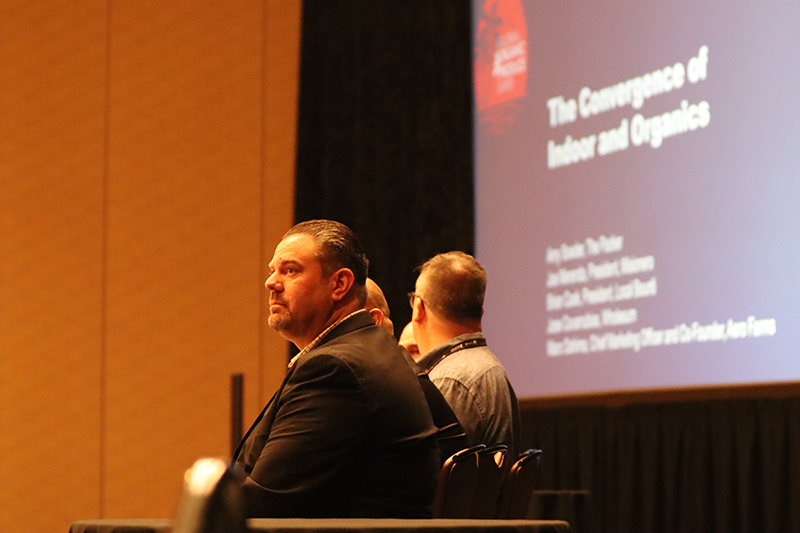High-tech or traditional, organic or conventional, growing indoors takes a tailored approach

HOLLYWOOD, Fla. — From high-tech, aeroponic nurseries all the way to traditional greenhouse crops rooted in soil, many growing methods and technologies fit under the wide umbrella of controlled environment agriculture.
Cultivating fruits and vegetables in indoor environments can appear vastly different depending on the production style, region and grower, with new advances being developed and tested every day.
Fostering partnerships and strengthening the CEA-grown produce category increasingly depends on working holistically with each grower and their unique needs, challenges and markets, said industry leaders during an education panel at the Global Organic Produce Expo, held Jan. 30-Feb. 1 at the Seminole Hard Rock Hotel and Casino.
While the panelists represented a diverse range of farming models and approaches to growing, they all agreed that convergence — working together to solve problems instead of hunkering down into siloed camps — was key to building strong, resilient companies and a CEA movement that delivers what consumers are looking for.
The discussion was moderated by Amy Sowder, editor of retail, education and PMG magazine at The Packer.
Tackling challenges together
“At the end of the day, field and CEA — they’re complementary; they’re not fighting against each other. It’s about finding the right solution, the right region and the right problem that you want to embrace,” said Jose Covarrubias, general manager at Wholesum Farms. Wholesum grows vegetables in Arizona, Mexico and South America, which includes tomatoes cultivated under glass.
The most exciting thing about CEA, Covarrubias said, is that it gives growers the opportunity to grow many different varieties of produce with a lot fewer resources.
“That's the sustainability piece that’s very important to us at Wholesum,” he added.
Related news: ‘History is on our side’: Paul Rice, Fair Trade USA CEO and founder, inspires at GOPEX 2023
Marc Oshima, co-founder and chief marketing officer at high-tech vertical farming company AeroFarms agreed that his company’s approach to growing made it possible to use fewer resources than traditional farming.
“This is the heart of the work we're doing in AeroFarms. We’re reimagining farms,” Oshima said.
In AeroFarm’s high-tech aeroponic vertical farms, according to Oshima, the team scrutinizes inputs, continually looking for ways to improve.
“How do we do more with less? How do farm in a more sustainable way?” Oshima continued. “At AeroFarms, we use 95% less water, zero pesticides.”
On the other end of the spectrum, the self-identified traditional farmer on the panel, Joe Merenda, president of Misionero, said his company first got involved with indoor growing in 2021 to strengthen its operation overall.
“We started a strategic alliance with one of our partners in Mexico, who are one of the largest CEA growers in Mexico, in order to maximize our supply chain and figure out how we could solve some problems with traditional farming practices through that model.”
“For us and this convergence conversation, we look at it as it's less about the convergence of organic and CEA,” Merenda continued. “For us, more of it is about the convergence of traditional ag and CEA getting together and trying to solve problems for retailers.”
Brian Cook, president of Local Bounti, a CEA grower that blends vertical farming with greenhouse growing, agreed that it comes down to a thoughtful strategy that is focused on ensuring consistent, fresh product on shelf.
“I think you break it down to what it is at its core, and it comes down to supply chain resiliency,” Cook said.

Convergence of organic production and indoor ag
The recent update to the National Organic Program and its new Strengthening Organic Enforcement final rule has sparked fresh produce businesses across the supply chain to take stock and confirm that they have done their homework.
And while CEA and indoor agriculture approaches farming in a new way with unique challenges, many on the panel welcome increased organic enforcement.
“At Local Bounti, we grow organically in greenhouses, so I have a deep fondness for the organic label and what it means. I think it's important to continue and ensure that integrity ... goes along with what that label stands for,” Cook said. “So anytime there's the checking of the boxes in the process, I think that it just strengthens what organic means.”
Related news: USDA’s new organic rule tackles fraud
For some panelists, how marketers and business leaders frame the organic and CEA discussion is the key to moving the movements forward.
“We have strict standards on the organic side, but that has not been put together yet on the CEA side,” Merenda said. “How do we give the consumer the right message when there really is no standard to that message? So, I think the next step is getting the message consistent and getting the practices doing the same thing. Instead of saying this one’s better than the other, let's just describe what we're doing and why it's good for the consumer.
“I think it's the messaging to the consumer that's going to make the biggest difference in how [organic certification and CEA] is perceived,” Merenda added.







